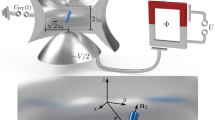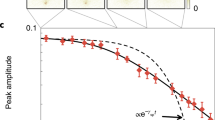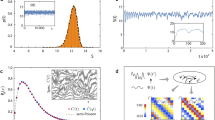Abstract
The key to explaining and controlling a range of quantum phenomena is to study how information propagates around many-body systems. Quantum dynamics can be described by particle-like carriers of information that emerge in the collective behaviour of the underlying system, the so-called quasiparticles1. These elementary excitations are predicted to distribute quantum information in a fashion determined by the system’s interactions2. Here we report quasiparticle dynamics observed in a quantum many-body system of trapped atomic ions3,4. First, we observe the entanglement distributed by quasiparticles as they trace out light-cone-like wavefronts5,6,7,8,9,10,11. Second, using the ability to tune the interaction range in our system, we observe information propagation in an experimental regime where the effective-light-cone picture does not apply7,12. Our results will enable experimental studies of a range of quantum phenomena, including transport13,14, thermalization15, localization16 and entanglement growth17, and represent a first step towards a new quantum-optic regime of engineered quasiparticles with tunable nonlinear interactions.
This is a preview of subscription content, access via your institution
Access options
Subscribe to this journal
Receive 51 print issues and online access
$199.00 per year
only $3.90 per issue
Buy this article
- Purchase on Springer Link
- Instant access to full article PDF
Prices may be subject to local taxes which are calculated during checkout




Similar content being viewed by others
References
Sachdev, S. Quantum criticality: competing ground states in low dimensions. Science 288, 475–480 (2000)
Calabrese, P. & Cardy, J. Time-dependence of correlation functions following a quantum quench. Phys. Rev. Lett. 96, 136801 (2006)
Porras, D. & Cirac, J. I. Effective quantum spin systems with trapped ions. Phys. Rev. Lett. 92, 207901 (2004)
Friedenauer, H., Schmitz, H., Glueckert, J., Porras, D. & Schaetz, T. Simulating a quantum magnet with trapped ions. Nature Phys. 4, 757–761 (2008)
Lieb, E. & Robinson, D. The finite group velocity of quantum spin systems. Commun. Math. Phys. 28, 251–257 (1972)
Cramer, M., Serafini, A. & Eisert, J. in Quantum Information and Many Body Quantum Systems (eds Ericsson, M. & Montangero, S. ) 51 (Edizioni della Normale, 2008)
Hastings, M. B. in Quantum Theory from Small to Large Scales, Lecture Notes of the Les Houches Summer School (eds Frohlich, J., Salmhofer, M., Mastropietro, V., Roeck, W. D. & Cugliandolo, L. ) Vol. 95, Ch. 5 (Oxford Univ. Press, 2010)
Nachtergaele, B. & Sims, R. Much ado about something: why Lieb-Robinson bounds are useful. IAMP News Bull. 22–29. (October 2010)
Cheneau, M. et al. Light-cone-like spreading of correlations in a quantum many-body system. Nature 481, 484–487 (2012)
Fukuhara, T. et al. Microscopic observation of magnon bound states and their dynamics. Nature 502, 76–79 (2013)
Langen, T., Geiger, R., Kuhnert, M., Rauer, B. & Schmiedmayer, J. Local emergence of thermal correlations in an isolated quantum many-body system. Nature Phys. 9, 640–643 (2013)
Hauke, P. & Tagliacozzo, L. Spread of correlations in long-range interacting quantum systems. Phys. Rev. Lett. 111, 207202 (2013)
Bose, S. Quantum communication through spin chain dynamics: an introductory overview. Contemp. Phys. 48, 13–30 (2007)
Rebentrost, P., Mohseni, M., Kassal, I., Lloyd, S. & Aspuru-Guzik, A. Environment-assisted quantum transport. New J. Phys. 11, 033003 (2009)
Rigol, M., Dunjko, V., Yurovsky, V. & Olshanii, M. Relaxation in a completely integrable many-body quantum system: an ab initio study of the dynamics of the highly excited states of 1D lattice hard-core bosons. Phys. Rev. Lett. 98, 050405 (2007)
Yao, N. Y. et al. Many-body localization with dipoles. Preprint at http://arXiv.org/abs/1311.7151 (2014)
Schachenmayer, J., Lanyon, B. P., Roos, C. F. & Daley, A. J. Entanglement growth in quench dynamics with variable range interactions. Phys. Rev. X 3, 031015 (2013)
Kitaev, A. Fault-tolerant quantum computation by anyons. Ann. Phys. 303, 2–30 (2003)
Bravyi, S., Hastings, M. B. & Verstraete, F. Lieb-Robinson bounds and the generation of correlations and topological quantum order. Phys. Rev. Lett. 97, 050401 (2006)
Eisert, J. & Osborne, T. General entanglement scaling laws from time evolution. Phys. Rev. Lett. 97, 150404 (2006)
Jünemann, J., Cadarso, A., Perez-Garcia, D., Bermudez, A. & Garcia-Ripoll, J. Lieb- Robinson bounds for spin-boson lattice models and trapped ions. Phys. Rev. Lett. 111, 230404 (2013)
Eisert, J., van den Worm, M., Manmana, S. R. & Kastner, M. Breakdown of quasi-locality in long-range quantum lattice models. Phys. Rev. Lett. 111, 260401 (2013)
Kim, K. et al. Entanglement and tunable spin-spin couplings between trapped ions using multiple transverse modes. Phys. Rev. Lett. 103, 120502 (2009)
Britton, J. W. et al. Engineered two-dimensional Ising interactions in a trapped-ion quantum simulator with hundreds of spins. Nature 484, 489–492 (2012)
Islam, R. et al. Emergence and frustration of magnetism with variable-range interactions in a quantum simulator. Science 340, 583–587 (2013)
Richerme, P. et al. Non-local propagation of correlations in long-range interacting quantum systems. Nature http://dx.doi.org/10.1038/nature13450 (this issue)
Plenio, M. B. & Huelga, S. F. Dephasing-assisted transport: quantum networks and biomolecules. New J. Phys. 10, 113019 (2008)
Gong, Z.-X. & Duan, L.-M. Prethermalization and dynamical transition in an isolated trapped ion spin chain. New J. Phys. 15, 113051 (2013)
Schindler, P. et al. A quantum information processor with trapped ions. New J. Phys. 15, 123012 (2013)
Roos, C. F. et al. Bell states of atoms with ultralong lifetimes and their tomographic state analysis. Phys. Rev. Lett. 92, 220402 (2004)
Holstein, T. & Primakoff, H. Field dependence of the intrinsic domain magnetization of a ferromagnet. Phys. Rev. 58, 1098–1113 (1940)
Sørensen, A. & Mølmer, K. Quantum computation with ions in thermal motion. Phys. Rev. Lett. 82, 1971–1974 (1999)
Häffner, H. et al. Precision measurement and compensation of optical Stark shifts for an ion-trap quantum processor. Phys. Rev. Lett. 90, 143602 (2003)
James, D. F. V., Kwiat, P. G., Munro, W. J. & White, A. G. Measurement of qubits. Phys. Rev. A 64, 052312 (2001)
Wootters, W. K. Entanglement of formation of an arbitrary state of two qubits. Phys. Rev. Lett. 80, 2245–2248 (1998)
Hastings, M. B. Lieb-Schultz-Mattis in higher dimensions. Phys. Rev. B 69, 104431 (2004)
Nachtergaele, B. & Sims, R. Lieb-Robinson bounds and the exponential clustering theorem. Commun. Math. Phys. 265, 119–130 (2006)
Acknowledgements
We acknowledge discussions with L. Tagliacozzo, M. Heyl, A. Gorshkov and S. Bose. This work was supported by the Austrian Science Fund (FWF) under grant number P25354-N20, and by the European Commission via the integrated project SIQS and by the Institut für Quanteninformation. We also acknowledge support from the European Research Council through the CRYTERION Project (number 227959).
Author information
Authors and Affiliations
Contributions
P.H., B.P.L. and C.F.R. developed the research, based on theoretical ideas conceived with P.Z.; P.J., B.P.L., C. H. and C.F.R. performed the experiments; B.P.L., P.J., C.F.R. and P.H. analysed the data and carried out numerical simulations. P.J., C.H., B.P.L., R.B. and C.F.R. contributed to the experiment; B.P.L., C.F.R., P.H., P.Z. and R.B. wrote the manuscript; all authors contributed to discussions of the results and of the manuscript.
Corresponding author
Ethics declarations
Competing interests
The authors declare no competing financial interests.
Extended data figures and tables
Extended Data Figure 1 Quantum dynamics following local quenches in a seven-ion (seven-spin) system.
a–c, Time evolution of the spatially resolved magnetization  (colour coded as in Fig. 2) for three different local quenches. In each panel measured data (left-hand side) is shown next to theoretical calculations for the ideal case (right-hand side). a and d, Quench at the centre spin, α ≈ 1.36; b and e, quench at the leftmost spin, α ≈ 1.36; c and f, quench at both ends of the chain, α ≈ 1.75. Theoretical calculations employ measured laser–ion coupling strengths and distribution across the ion chain.
(colour coded as in Fig. 2) for three different local quenches. In each panel measured data (left-hand side) is shown next to theoretical calculations for the ideal case (right-hand side). a and d, Quench at the centre spin, α ≈ 1.36; b and e, quench at the leftmost spin, α ≈ 1.36; c and f, quench at both ends of the chain, α ≈ 1.75. Theoretical calculations employ measured laser–ion coupling strengths and distribution across the ion chain.
Extended Data Figure 2 Quantum dynamics following a global quench in a seven-ion (seven-spin) system.
a, Measured correlation matrices with elements  (colour coded) at t = 0 ms, 5 ms, and 10 ms (α ≈ 1.75). b, Measured average magnetic spin–spin correlations
(colour coded) at t = 0 ms, 5 ms, and 10 ms (α ≈ 1.75). b, Measured average magnetic spin–spin correlations  (colour coded) as a function of time and distance n where the average was taken over all spin pairs (i, j) with |i − j| = n. c, Calculated spin–spin correlations
(colour coded) as a function of time and distance n where the average was taken over all spin pairs (i, j) with |i − j| = n. c, Calculated spin–spin correlations  (colour code: note the different colour scale) as a function of time and distance.
(colour code: note the different colour scale) as a function of time and distance.
Extended Data Figure 3 Entanglement distributed by quasiparticles.
Following a quench of the central spin with short-range interactions (α ≈ 1.75), a distinct wavefront emerges. Each panel shows data (left-hand side) and theory (right-hand side) a, Measured single-spin magnetization (colour coded as in Fig. 2). b, Single-spin von Neumann entropy −Tr(ρlog(ρ)) normalized to one, derived from measured density matrices. Zero would correspond to a fully pure quantum state (black) and one (white) to a fully mixed state. The increase in entropy of any individual spin during the dynamics reflects the generation of entanglement with other spins. c, Real part of the tomographically reconstructed full density matrix of spins 3 and 5 at a time 9 ms after the quench. Imaginary parts are less than 0.03. The fidelity between the full experimentally reconstructed ρ and ideal state |ψ〉 is F = 0.975 ± 0.005, using  .
.
Extended Data Figure 4 Quantum dynamics following a local quench in a 15-ion (15-spin) system.
a–c, Experimentally measured time evolution of  (as in Fig. 4a–c). d–f, Theoretical calculations based on a measured spin–spin interaction matrix (such as presented in Fig. 1b). h–i, Theoretical calculations using
(as in Fig. 4a–c). d–f, Theoretical calculations based on a measured spin–spin interaction matrix (such as presented in Fig. 1b). h–i, Theoretical calculations using  , with
, with  and α extracted from a fit to the measured dispersion relation. All theory calculations are done in the single-excitation subspace. j–l, Magnetization of symmetric pairs around the centre ion as a function of time: blue, ions 7 and 9; cyan, ions 6 and 10; purple, ions 5 and 11); red, ions 4 and 12; black, ions 3 and 13. The dashed lines are Gaussian fits to the measured arrival time of the first quasiparticle maximum (from a–c). m–o, Excluding the outermost ion to reduce finite-size effects, the fitted measured arrival maxima (circles) trace approximately a straight line when plotted against distance from quench site. A linear fit (solid line) yields an estimate for the propagation speed of the first quasiparticle maximum.
and α extracted from a fit to the measured dispersion relation. All theory calculations are done in the single-excitation subspace. j–l, Magnetization of symmetric pairs around the centre ion as a function of time: blue, ions 7 and 9; cyan, ions 6 and 10; purple, ions 5 and 11); red, ions 4 and 12; black, ions 3 and 13. The dashed lines are Gaussian fits to the measured arrival time of the first quasiparticle maximum (from a–c). m–o, Excluding the outermost ion to reduce finite-size effects, the fitted measured arrival maxima (circles) trace approximately a straight line when plotted against distance from quench site. A linear fit (solid line) yields an estimate for the propagation speed of the first quasiparticle maximum.
Extended Data Figure 5 Example of a spin–spin interaction matrix Jij.
The plot compares theory and experiment. Each element of the Jij matrix is measured directly (see Methods) in a system of N = 7 spins (solid coloured bars). Overlaid transparent bars with blue edges correspond to the results of a simulation which takes the following experimental parameters into account: the trapping frequencies; frequency of the bichromatic laser beams (see Methods); and measured individual laser–ion Rabi frequencies. The experimental data shown here are the same as in Fig. 1c. The elements J16, J27 and J17 were not measured. Small black vertical lines show one standard deviation in the experimentally measured elements.
Rights and permissions
About this article
Cite this article
Jurcevic, P., Lanyon, B., Hauke, P. et al. Quasiparticle engineering and entanglement propagation in a quantum many-body system. Nature 511, 202–205 (2014). https://doi.org/10.1038/nature13461
Received:
Accepted:
Published:
Issue Date:
DOI: https://doi.org/10.1038/nature13461
This article is cited by
-
Cavity-mediated long-range interactions in levitated optomechanics
Nature Physics (2024)
-
Exploring large-scale entanglement in quantum simulation
Nature (2023)
-
Quantum transports in two-dimensions with long range hopping
Scientific Reports (2023)
-
Quantum correlations in the frustrated XY model on the honeycomb lattice
Scientific Reports (2023)
-
Continuous symmetry breaking in a two-dimensional Rydberg array
Nature (2023)
Comments
By submitting a comment you agree to abide by our Terms and Community Guidelines. If you find something abusive or that does not comply with our terms or guidelines please flag it as inappropriate.



